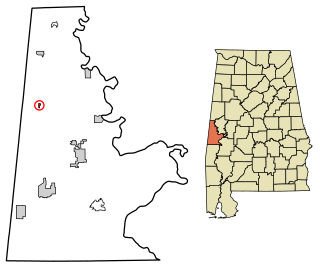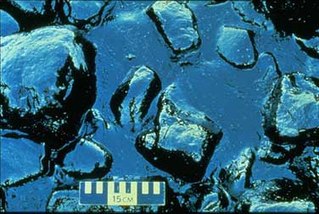
Emelle is a town in Sumter County, Alabama, United States. It was named after the daughters of the man who donated the land for the town. The town was started in the 19th century but not incorporated until 1981. The daughters of the man who donated were named Emma Dial and Ella Dial, so he combined the two names to create Emelle. Emelle was famous for its great cotton. The first mayor of Emelle was James Dailey. He served two terms. The current mayor is Roy Willingham Sr. The population was 32 at the 2020 census.

Chalmette is a census-designated place (CDP) in, and the parish seat of, St. Bernard Parish in southeastern Louisiana, United States. The 2010 census reported that Chalmette had 16,751 people; 2011 population was listed as 17,119; however, the pre-Katrina population was 32,069 at the 2000 census. At the 2020 U.S. census, its population rebounded to 21,562. Chalmette is part of the New Orleans–Metairie–Kenner metropolitan statistical area. Chalmette is located east of downtown New Orleans and south of Arabi, towards Lake Borgne.

Xavier University of Louisiana is a private, historically black (HBCU), Catholic university in New Orleans, Louisiana. It is the only Catholic HBCU and, upon the canonization of Katharine Drexel in 2000, became the first Catholic university founded by a saint.

Environmental racism, ecological racism or ecological apartheid is a form of institutional racism leading to landfills, incinerators, and hazardous waste disposal being disproportionately placed in communities of color. Internationally, it is also associated with extractivism, which places the environmental burdens of mining, oil extraction, and industrial agriculture upon indigenous peoples and poorer nations largely inhabited by people of color.

Cancer Alley is the regional nickname given to an 85-mile (137 km) stretch of land along the Mississippi River between Baton Rouge and New Orleans, in the River Parishes of Louisiana, which contains over 200 petrochemical plants and refineries. This area accounts for 25% of the petrochemical production in the United States. Environmentalists consider the region a sacrifice zone where rates of cancer caused by air pollution exceed the federal government's own limits of acceptable risk. Others have referred to the same region as "Death Alley".
Environmental justice or eco-justice, is a social movement to address environmental injustice, which occurs when poor and marginalized communities are harmed by hazardous waste, resource extraction, and other land uses from which they do not benefit. The movement has generated hundreds of studies showing that exposure to environmental harm is inequitably distributed.

Hurricane Katrina struck the United States on August 29, 2005, causing over a thousand deaths and extreme property damage, particularly in New Orleans. The incident affected numerous areas of governance, including disaster preparedness and environmental policy.

The Common Ground Collective is a decentralized network of non-profit organizations offering support to the residents of New Orleans. It was formed in the fall of 2005 in the Algiers neighborhood of the city in the days after Hurricane Katrina resulted in widespread flooding, damage and deaths throughout the city.

As with many countries, pollution in the United States is a concern for environmental organizations, government agencies and individuals.
The Tulane Environmental Law Clinic (TELC) is a legal clinic that Tulane Law School has operated since 1989 to offer law students the practical experience of representing real clients in actual legal proceedings under state and federal environmental laws.

Robert Doyle Bullard is an American academic who is the former Dean of the Barbara Jordan - Mickey Leland School Of Public Affairs and currently Distinguished Professor at Texas Southern University. Previously Ware Professor of Sociology and Director of the Environmental Justice Resource Center at Clark Atlanta University, Bullard is known as the "father of environmental justice". He has been a leading campaigner against environmental racism, as well as the foremost scholar of the problem, and of the Environmental Justice Movement which sprung up in the United States in the 1980s.

Naled (Dibrom) is an organophosphate insecticide. Its chemical name is dimethyl 1,2-dibromo-2,2-dichloroethylphosphate.
Stephen Bradberry is a community organizer in New Orleans, Louisiana, USA. In 2005, he served as the lead organizer for the New Orleans chapter of the Association of Community Organizations for Reform Now (ACORN). He was awarded the Robert F. Kennedy Human Rights Award for his work on behalf of victims of Hurricane Katrina.
A fenceline community or frontline community is a neighborhood that is immediately adjacent to a company, military base, industrial or service center and is directly affected by the noise, odors, chemical emissions, traffic, parking, or operations of the company. These communities are exposed to hazardous chemicals, high pollution levels, and environmental degradation along with the threat of chemical explosions.
McCastle v. Rollins is a case that was filed on behalf of the residents of Alsen, Louisiana against Rollins Environmental Services, Inc., and. Although the decision in this case allowed the plaintiffs within this community to be certified as a class, and allowed them to be viewed as a unit when filing their lawsuit, and thereby reversing the decision that had been made at the trial and appellate level, the case was not reheard in the lower courts. Instead, Rollins Environmental Services, Inc. settled with the plaintiffs outside of court in 1987. Although this case is primarily cited for what a group of people need to do in order to obtain class certification, it is also often cited as one of the pivotal moments in the Environmental justice grass roots movement that has been occurring within communities of color. The people involved in the suit look at the way in which their community was disproportionately impacted by toxic waste polluters in light of their race and class, in comparison to communities that are composed of people who are racially and economically privileged and advocated for more considerate treatment by state regulators and operators of waste disposal plants. Through looking at the development of the McCastle v. Rollins lawsuit, one can see the way in which class, race, legal claims, community activism, public health and environmentalism can be viewed and used in conjunction with one another to protect the rights of people living within a given community.
A sacrifice zone or sacrifice area is a geographic area that has been permanently changed by heavy environmental alterations or economic disinvestment, often through locally unwanted land use (LULU). Commentators including Chris Hedges, Joe Sacco, and Steve Lerner have argued that corporate business practices contribute to producing sacrifice zones. A 2022 report by the UN highlighted that millions of people globally are in pollution sacrifice zones, particularly in zones used for heavy industry and mining.
Concerned Citizens of South Central Los Angeles(CCSCLA) is a non-profit 501(c)3 community-based organization whose mission is to work for social justice and economic and environmental change within the South Central community. CCSCLA works to involve community members in identifying social, economic, and environmental areas of concern to them, and give them the tools necessary to engage with institutions, such as industries or political leaders, to enact change.
Margaret Prescod is an activist, author, journalist and radio host. She was a founder of The Black Coalition Fighting Back Serial Murders and of Black Women for Wages for Housework. Prescod is on the executive board of the Center for the Study of Racism, Social Justice & Health, at UCLA's Fielding School of Public Health.

Dumping in Dixie is a 1990 book by the American professor, author, activist, and environmental sociologist Robert D. Bullard. Bullard spotlights the quintessence of the economic, social, and psychological consequences induced by the siting of noxious facilities in mobilizing the African American community. Starting with the assertion that every human has the right to a healthy environment, the book documents the journey of five American communities of color as they rally to safeguard their health and homes from the lethal effects of pollution. Further, Bullard investigates the heterogeneous obstacles to social and environmental justice that African American communities often encounter. Dumping in Dixie is widely acknowledged as the first book to discuss environmental injustices and distill the concept of environmental justice holistically. Since the publication of Dumping in Dixie, Bullard has emerged as one of the seminal figures of the environmental justice movement; some even label Bullard as the "father of environmental justice".
Environmental racism is a form of institutional racism, in which people of colour bear a disproportionate burden of environmental harms, such as pollution from hazardous waste disposal and the effects of natural disasters. Environmental racism exposes Native Americans, African Americans, Asian Americans, Pacific Islanders, and Hispanic populations to physical health hazards and may negatively impact mental health. It creates disparities in many different spheres of life, such as transportation, housing, and economic opportunity.











